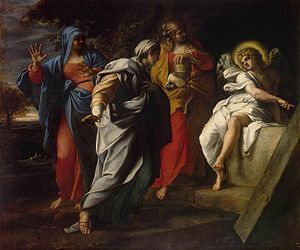Salome

Salome was a woman disciple of Jesus identified by name only in the Gospel of Mark at Mark 15:40 and Mark 16:1 . It is a near-certainty that Salome was Mark's mother and a central inspiration for this first gospel chronologically because:
- Mark was young enough[1] to be the son of the wise adult woman Salome, and he gives her unique credit in the ending of the Gospel of Mark;
- Indeed, the ending viewed by some as abrupt in the Gospel of Mark can be understood as Mark giving credit to the important role of Salome, as his mother;
- Despite being well-known to Mark, Salome was unknown to Matthew and other Apostles;
- Mark based his belief in the Resurrection on the authority of Salome witnessing the empty tomb and the angel;
- both Mark and Salome preferred Aramaic in a community that preferred Greek or Hebrew;
- Salome was central to a small group of women who followed Jesus;
- Mark references a private discussion by a few, presumably including young Mark's mother Salome, who followed Jesus in addition to the Apostles, at Mark 4:10; and
- both Mark and Salome were among the few who witnessed the Crucifixion.
Salome was a common Aramaic name at the time, and is used today.[2] In modesty, Mark did not explain who Salome was because she was almost certainly Mark's mother, who as a follower of Jesus enabled her child Mark to be an eyewitness to Jesus's ministry. Mark was also Aramaic, as he used far more statements of Jesus in Aramaic than any other Gospel. Query: was Salome an observer of the Sabbath, as one might infer from Mark 16:1 , or is the reference merely a common Aramaic way to reference the end of a week?
Matthew apparently did not know who Salone was, as he copied from the Gospel of Mark and yet omitted two references to her by Mark at Mark 15:40 and Mark 16:1 . In particular, Matthew omitted the presence of Salome or any third woman from the visit to the tomb of Jesus, described by Matthew 28:1 (only two women) and Mark 16:1 .
The group of women who financially supported the disciples of Jesus are generally referenced in Luke 8:3.[3]
Two alternative theories are that (1) Salome was the mother of John the Apostle (but why doesn't he mention her, if that were true), or (2) Salome was the dancer who, at the urging of her mother, demanded the beheading of John the Baptist but later converted (which would explain how Mark knew the details of that incident).
See also
References
- ↑ Mark is obviously referencing himself here as the boy here, as no other Gospel does: Mark 14:51-52 - mistranslated as "a young man" when it should be translated as "a youth" [1].
- ↑ https://themeaningofthename.com/salome/
- ↑ https://margmowczko.com/salome-follower-of-jesus-myrrh-bearer/